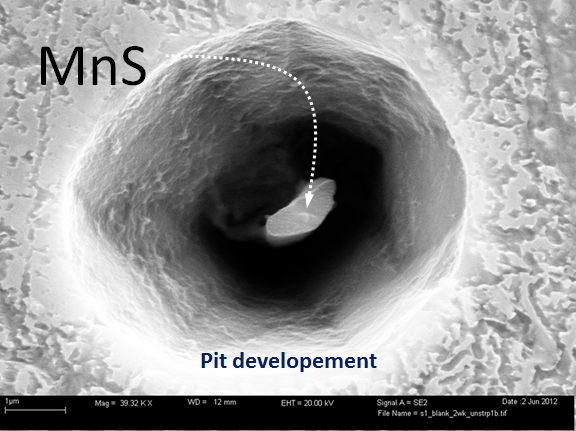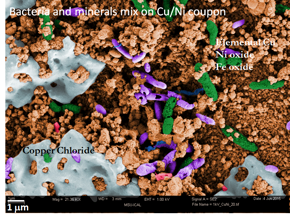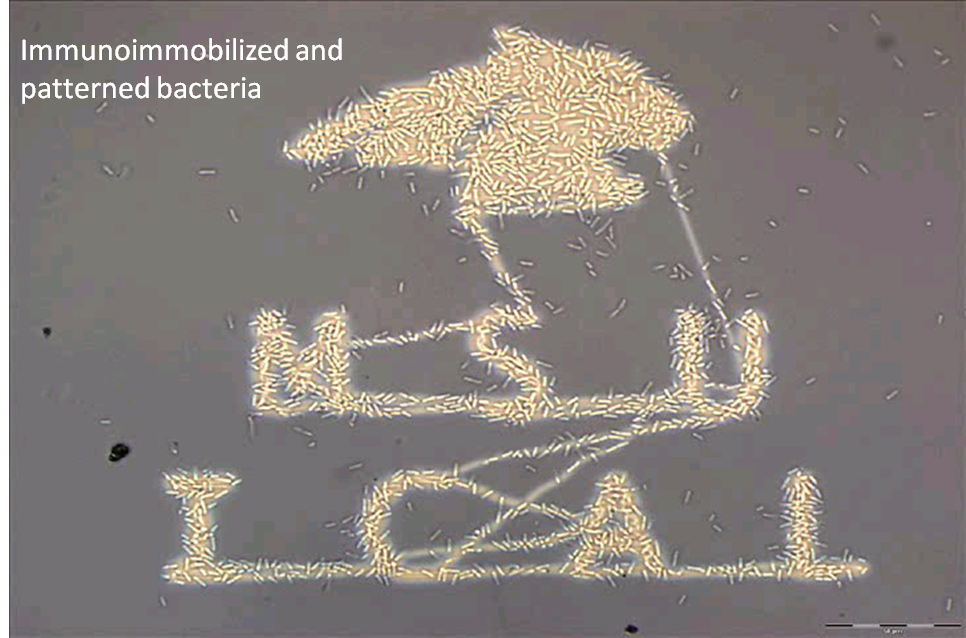Research Projects in Biophysics at MSU
Biocorrosion | Immobilization of Bacteria
Biocorrosion (Dr. Avci and Dr. Nandasiri)
Corrosion science is a mature field of study. The presence and activities of microorganisms enhance the process of corrosion; this is known as biocorrosion. The annual cost of corrosion, including the cost of preventive measures, exceeded 1.0 trillion dollars in 2016; this is more than 6% of the US GDP. The cost of corrosion is the largest single expense in the US economy, yet understanding the fundamentals of corrosion, particularly in relation to the role of metallurgy in the degradation of materials, and educating the 21st century workforce in this field do not receive the attention they deserve. The field of corrosion is a convergent science, and a multidisciplinary approach is an absolute necessity. We are actively collaborating with groups in other disciplines in and outside MSU. The Center for Biolfilm Engineering (http://www.biofilm.montana.edu/ ) is actively working to establish a Biocorrosion Center at MSU in close collaboration with the Physics Department through the ICAL facility.
Steel is the most widely used metal in US infrastructure. Currently our group is focused
on understanding the role of crystal defects in the localized bio-corrosion of low-carbon steel, where corrosion processes taking place
at the nanoscale can be related to the macroscopic failure of steel in real world
applications. Most nanoscale defects in carbon steel are localized in phase boundaries
between MnS-like inclusions and ferrite grains and at interfaces of cementite/ferrite
lamellar structures in pearlite grains. The figure on the right shows an example of
pit initiation and development on carbon steel exposed to a biocorrosive environment.
We have a very well equipped laboratory, the Image and Chemical Analysis Laboratory
(ICAL: www.physics.montana.edu/ical ), to investigate materials with nanoscale spatial and spectral resolution in order
to take our fundamental understanding of biocorrosion processes to the next level.
Most of our work is conducted at ICAL, though we are in close collaboration with
other facilities associated with the prestigious Montana Nanotechnology Facility (www.nano.montana.edu ), of which ICAL is a part. ICAL recently acquired a unique hybrid Auger nanoprobe
system that can be used to investigate and characterize structural defects with nanoscale
resolution. This will lead to the identification and mapping of locations on metal
surfaces where localized pit initiation will take place before steel is exposed to
a corrosive environment.
localized bio-corrosion of low-carbon steel, where corrosion processes taking place
at the nanoscale can be related to the macroscopic failure of steel in real world
applications. Most nanoscale defects in carbon steel are localized in phase boundaries
between MnS-like inclusions and ferrite grains and at interfaces of cementite/ferrite
lamellar structures in pearlite grains. The figure on the right shows an example of
pit initiation and development on carbon steel exposed to a biocorrosive environment.
We have a very well equipped laboratory, the Image and Chemical Analysis Laboratory
(ICAL: www.physics.montana.edu/ical ), to investigate materials with nanoscale spatial and spectral resolution in order
to take our fundamental understanding of biocorrosion processes to the next level.
Most of our work is conducted at ICAL, though we are in close collaboration with
other facilities associated with the prestigious Montana Nanotechnology Facility (www.nano.montana.edu ), of which ICAL is a part. ICAL recently acquired a unique hybrid Auger nanoprobe
system that can be used to investigate and characterize structural defects with nanoscale
resolution. This will lead to the identification and mapping of locations on metal
surfaces where localized pit initiation will take place before steel is exposed to
a corrosive environment.
The hybrid Auger nanoprobe combines a field emission Auger nanoprobe equipped with electron backscatter diffraction (EBSD) and energy dispersive X-ray (EDX) analysis capabilities. This combination enables the analysis of surface and bulk composition, crystal phase identification, crystallographic orientation, and strain on precisely the same spot at nearly the same time at nanometer scale. A high-precision floating Ar-ion gun enables accurate depth profiling and charge compensation on insulating materials. During the metallurgical preparation of steel (such as hot and cold rolling), plastic strain is induced within the iron lattice. The hybrid Auger nanoprobe allows us to map the strained regions on carbon steel or other materials, where evidence suggests that localized corrosion originates and develops. In the figure shown below, we demonstrate the power and utility of this instrument in experiments which would be impossible to conduct without the combined techniques available on the hybrid Auger nanoprobe system.

Biocorrosion is a highly interdisciplinary field. We are focused on the material science and material defects on the metal. However, this is only one aspect of this study. It is absolutely necessary to incorporate the chemical, biochemical, electrochemical and thermodynamical processes as well as the complex microbiological activities of communities of microorganisms in anaerobic and aerobic environments. At the end of the day, highly polished surfaces of metals do not look so polished because metals degrade and are covered with corrosion products and biomineral deposits, as shown and explained in the picture below. The student will not only have to understand the source of mineral deposits on the surface but also be able to predict the locations of metal erosion under these deposits. A student involved in such a research project will have to have a broad knowledge of interdisciplinary topics and a deep understanding of material science, including material defects and their themodynamics. The student will also have to learn a variety of material analytical techniques involving microscopy and spectroscopy, as described on the ICAL webpages.
Immobilization, trapping and concentration of bacteria for practical and fundamental studies (Dr. Recep Avci)
 Studies on immobilized individual living bacteria tethered on flat surfaces or trapping
and concentrating of trace bacteria in the environment enable fundamental studies
associated with the individual microorganism as well as addresses critical safety
issues through the development of a low-cost, reliable and easy-to-use method of capturing,
concentrating and identifying trace amounts of the pathogens that might be
Studies on immobilized individual living bacteria tethered on flat surfaces or trapping
and concentrating of trace bacteria in the environment enable fundamental studies
associated with the individual microorganism as well as addresses critical safety
issues through the development of a low-cost, reliable and easy-to-use method of capturing,
concentrating and identifying trace amounts of the pathogens that might be
present in environments such as drinking and washing water supplies, contaminated
food sources, and community health care facilities and hospitals, where trace amounts
of drug-resistant or other bacteria might be present. Typically, the concentrations
of infectious bacteria required for making people sick are far below the detection
limits of current techniques. The aim of our studies is to bridge this gap: It it
absolutely necessary to detect and identify the targeted pathogens in the environment rapidly, efficiently and reliably before the pathogens pose a serious health threat.
We can pattern and immobilize bacteria by means of antibody-antigen interactions as shown above. This requires layer-by-layer construction of immuno-immobilization conjugate chemistry on highly characterized flat surfaces such as Si-chips. Antibodies are specific to the surface antigens of the targeted bacteria such as fimbriae (pili) of bacteria, e.g. Salmonella (see figure above).
 Using this technology living bacteria can be patterned and tethered to a flat surface
as shown above with sufficient freedom of motion for bacteria to maintain their physiological
activities and viability, allowing individual bacteria to be manipulated: For example,
specific genes or nanoparticles can be inserted into the cytoplasm of bacteria by
means of a sharp AFM tip in order to observe genetic response of bacteria to such
introsion, or the elasticity of bacteria can be mapped with nm resolution. One can
investigate quorum sensing between groups of bacteria separated by immunoimmobilization.
Using this technology living bacteria can be patterned and tethered to a flat surface
as shown above with sufficient freedom of motion for bacteria to maintain their physiological
activities and viability, allowing individual bacteria to be manipulated: For example,
specific genes or nanoparticles can be inserted into the cytoplasm of bacteria by
means of a sharp AFM tip in order to observe genetic response of bacteria to such
introsion, or the elasticity of bacteria can be mapped with nm resolution. One can
investigate quorum sensing between groups of bacteria separated by immunoimmobilization.
Currently we are developing an efficient and reliable technology for the trapping and concentration of bacteria rapidly that we call BiyoTrap. A prototype device has been constructed based on activated 3D glass microfiber networks that are chemically modified in order to trap, capture and concentrate nonspecific bacteria with high efficiency and speed, using coulumbic charge as a means of capturing charged macromolecules or living organisms such as bacteria and DNA without the limitations of physical entrapment. The system can, in principle, process large volumes (i.e. liters) of liquid and concentrate trace bacterial contaminations (<0.1 cell/mL) into a volume of ~200 mL of the trap medium. In this way one can in principle achieve 2 to 4 orders of bacteria concentration in less than 20 min. An example of its application is shown in the figure above. Currently, the detection and identification limit of conventional technologies is ~100‑1000 cells/mL. BiyoTrap and related technologies are expected to improve on this by trapping and concentrating trace pathogens efficiently, rapidly and cost-effectively to a level at which current or emerging detection technologies can be utilized. Such an approach has the potential to identify a trace targeted pathogen in less than 30 min from start to finish, which is a considerable improvement over the 1‑2 days of culturing and growing bacteria needed to achieve concentrations at which current technologies can be used.
 Students working in this field will have to be well versed in surface science, conjugate
biochemistry and some microbiological techniques. Furthermore, students will need
to be trained in high-resolution microscopy and spectroscopy techniques such as high-end
optical microscopy, micro Raman spectroscopy and XPS spectroscopy and hybrid Auger
nanoprobe techniques, SEM and EDX microscopy and spectroscopy.
Students working in this field will have to be well versed in surface science, conjugate
biochemistry and some microbiological techniques. Furthermore, students will need
to be trained in high-resolution microscopy and spectroscopy techniques such as high-end
optical microscopy, micro Raman spectroscopy and XPS spectroscopy and hybrid Auger
nanoprobe techniques, SEM and EDX microscopy and spectroscopy.
